Comprehensive Report on Cognitive Assessment Methods & Analysis
VerifiedAdded on 2023/04/21
|9
|2594
|249
Report
AI Summary
This report provides a detailed overview of cognitive assessment methods, focusing on the evaluation of cognitive abilities such as attention, perception, short-term memory, and long-term memory. It includes a cognitive assessment conducted on a 17-year-old high school student named David, using task-based assessment methods like the Stroop test, Trail making test, Wechsler memory scale, and Digit span test. The results indicate that David possesses strong long-term memory but struggles with attention and short-term memory. The report concludes that addressing David's attention deficits could positively impact his overall cognitive performance and academic achievements. Desklib provides access to similar solved assignments and resources for students.
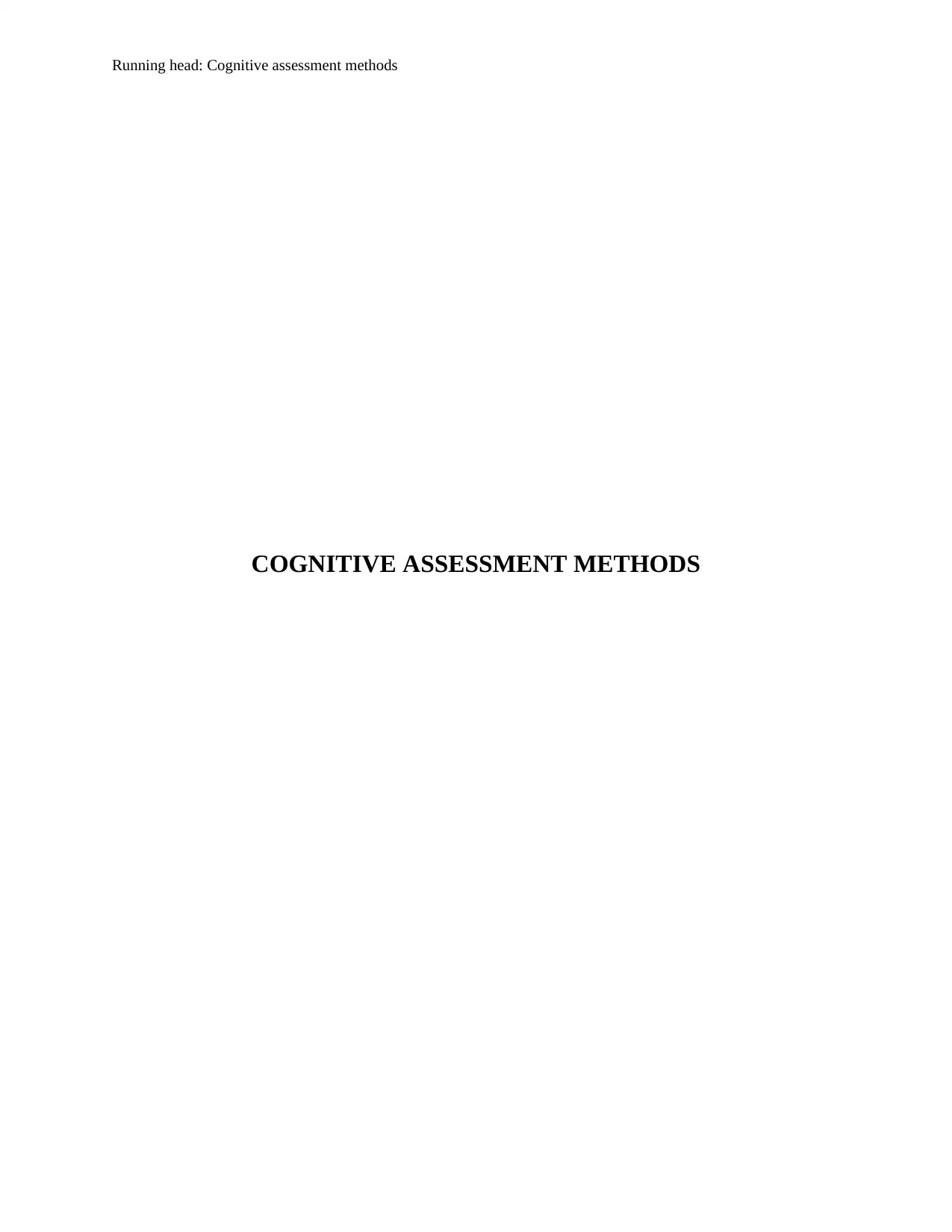
Running head: Cognitive assessment methods
COGNITIVE ASSESSMENT METHODS
COGNITIVE ASSESSMENT METHODS
Paraphrase This Document
Need a fresh take? Get an instant paraphrase of this document with our AI Paraphraser
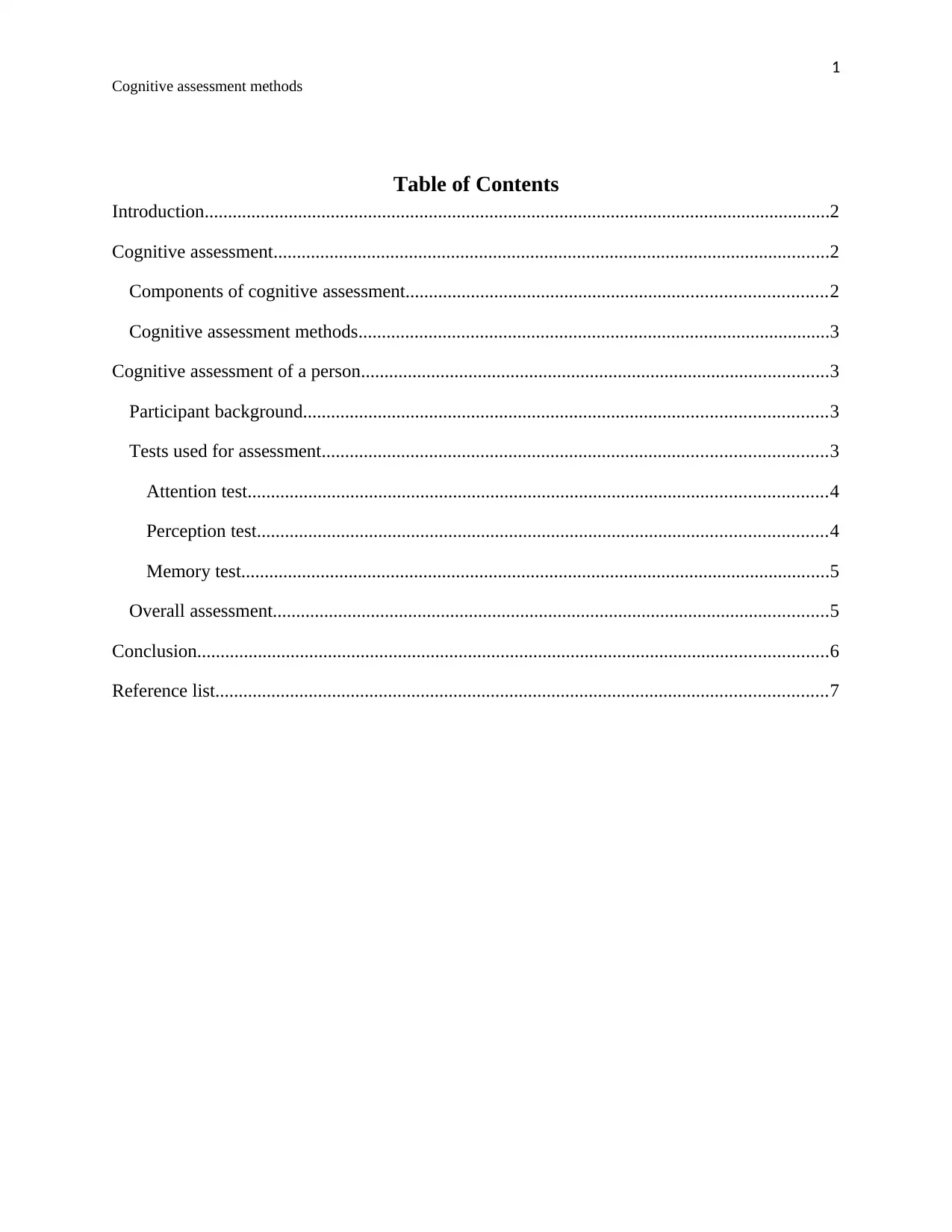
1
Cognitive assessment methods
Table of Contents
Introduction......................................................................................................................................2
Cognitive assessment.......................................................................................................................2
Components of cognitive assessment..........................................................................................2
Cognitive assessment methods.....................................................................................................3
Cognitive assessment of a person....................................................................................................3
Participant background................................................................................................................3
Tests used for assessment............................................................................................................3
Attention test............................................................................................................................4
Perception test..........................................................................................................................4
Memory test..............................................................................................................................5
Overall assessment.......................................................................................................................5
Conclusion.......................................................................................................................................6
Reference list...................................................................................................................................7
Cognitive assessment methods
Table of Contents
Introduction......................................................................................................................................2
Cognitive assessment.......................................................................................................................2
Components of cognitive assessment..........................................................................................2
Cognitive assessment methods.....................................................................................................3
Cognitive assessment of a person....................................................................................................3
Participant background................................................................................................................3
Tests used for assessment............................................................................................................3
Attention test............................................................................................................................4
Perception test..........................................................................................................................4
Memory test..............................................................................................................................5
Overall assessment.......................................................................................................................5
Conclusion.......................................................................................................................................6
Reference list...................................................................................................................................7
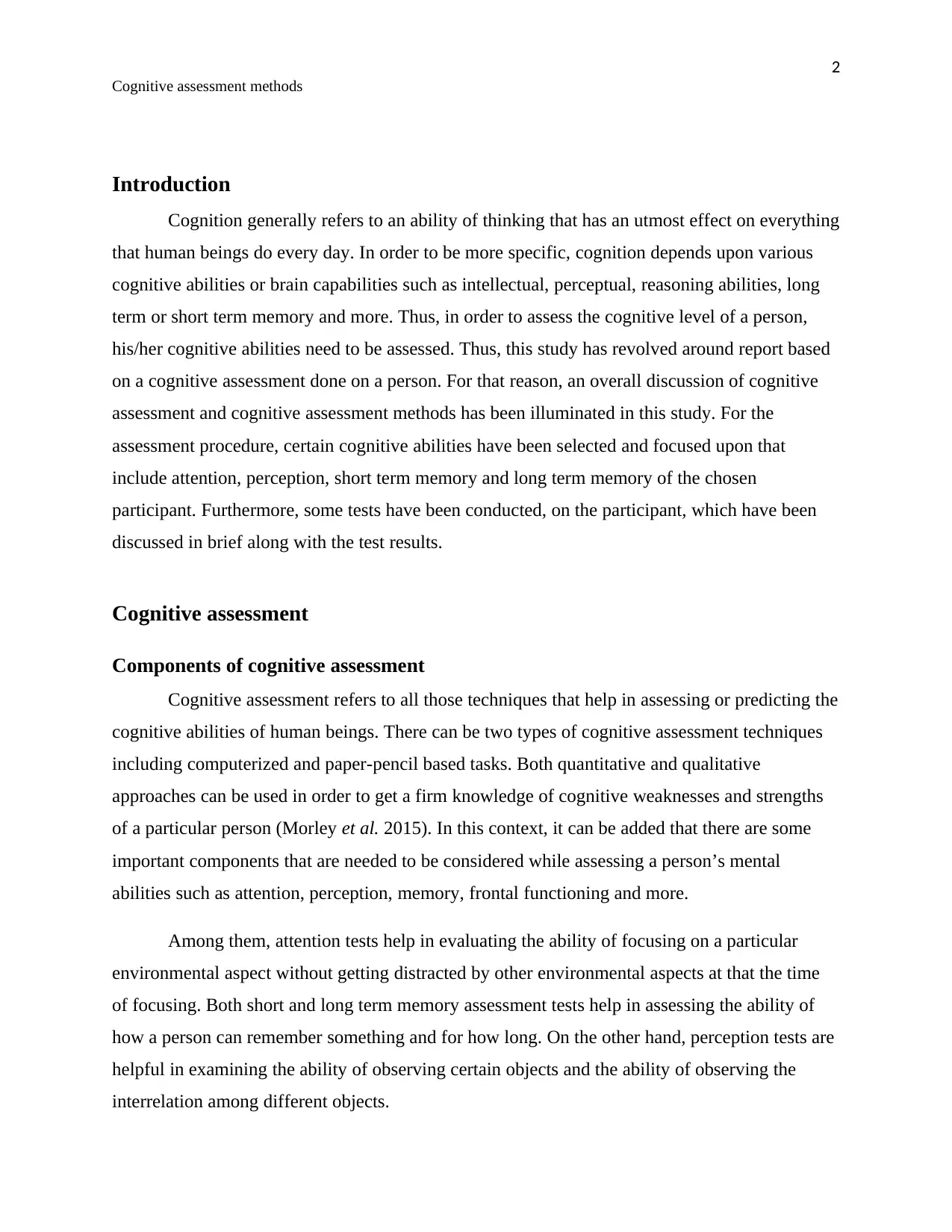
2
Cognitive assessment methods
Introduction
Cognition generally refers to an ability of thinking that has an utmost effect on everything
that human beings do every day. In order to be more specific, cognition depends upon various
cognitive abilities or brain capabilities such as intellectual, perceptual, reasoning abilities, long
term or short term memory and more. Thus, in order to assess the cognitive level of a person,
his/her cognitive abilities need to be assessed. Thus, this study has revolved around report based
on a cognitive assessment done on a person. For that reason, an overall discussion of cognitive
assessment and cognitive assessment methods has been illuminated in this study. For the
assessment procedure, certain cognitive abilities have been selected and focused upon that
include attention, perception, short term memory and long term memory of the chosen
participant. Furthermore, some tests have been conducted, on the participant, which have been
discussed in brief along with the test results.
Cognitive assessment
Components of cognitive assessment
Cognitive assessment refers to all those techniques that help in assessing or predicting the
cognitive abilities of human beings. There can be two types of cognitive assessment techniques
including computerized and paper-pencil based tasks. Both quantitative and qualitative
approaches can be used in order to get a firm knowledge of cognitive weaknesses and strengths
of a particular person (Morley et al. 2015). In this context, it can be added that there are some
important components that are needed to be considered while assessing a person’s mental
abilities such as attention, perception, memory, frontal functioning and more.
Among them, attention tests help in evaluating the ability of focusing on a particular
environmental aspect without getting distracted by other environmental aspects at that the time
of focusing. Both short and long term memory assessment tests help in assessing the ability of
how a person can remember something and for how long. On the other hand, perception tests are
helpful in examining the ability of observing certain objects and the ability of observing the
interrelation among different objects.
Cognitive assessment methods
Introduction
Cognition generally refers to an ability of thinking that has an utmost effect on everything
that human beings do every day. In order to be more specific, cognition depends upon various
cognitive abilities or brain capabilities such as intellectual, perceptual, reasoning abilities, long
term or short term memory and more. Thus, in order to assess the cognitive level of a person,
his/her cognitive abilities need to be assessed. Thus, this study has revolved around report based
on a cognitive assessment done on a person. For that reason, an overall discussion of cognitive
assessment and cognitive assessment methods has been illuminated in this study. For the
assessment procedure, certain cognitive abilities have been selected and focused upon that
include attention, perception, short term memory and long term memory of the chosen
participant. Furthermore, some tests have been conducted, on the participant, which have been
discussed in brief along with the test results.
Cognitive assessment
Components of cognitive assessment
Cognitive assessment refers to all those techniques that help in assessing or predicting the
cognitive abilities of human beings. There can be two types of cognitive assessment techniques
including computerized and paper-pencil based tasks. Both quantitative and qualitative
approaches can be used in order to get a firm knowledge of cognitive weaknesses and strengths
of a particular person (Morley et al. 2015). In this context, it can be added that there are some
important components that are needed to be considered while assessing a person’s mental
abilities such as attention, perception, memory, frontal functioning and more.
Among them, attention tests help in evaluating the ability of focusing on a particular
environmental aspect without getting distracted by other environmental aspects at that the time
of focusing. Both short and long term memory assessment tests help in assessing the ability of
how a person can remember something and for how long. On the other hand, perception tests are
helpful in examining the ability of observing certain objects and the ability of observing the
interrelation among different objects.
⊘ This is a preview!⊘
Do you want full access?
Subscribe today to unlock all pages.

Trusted by 1+ million students worldwide
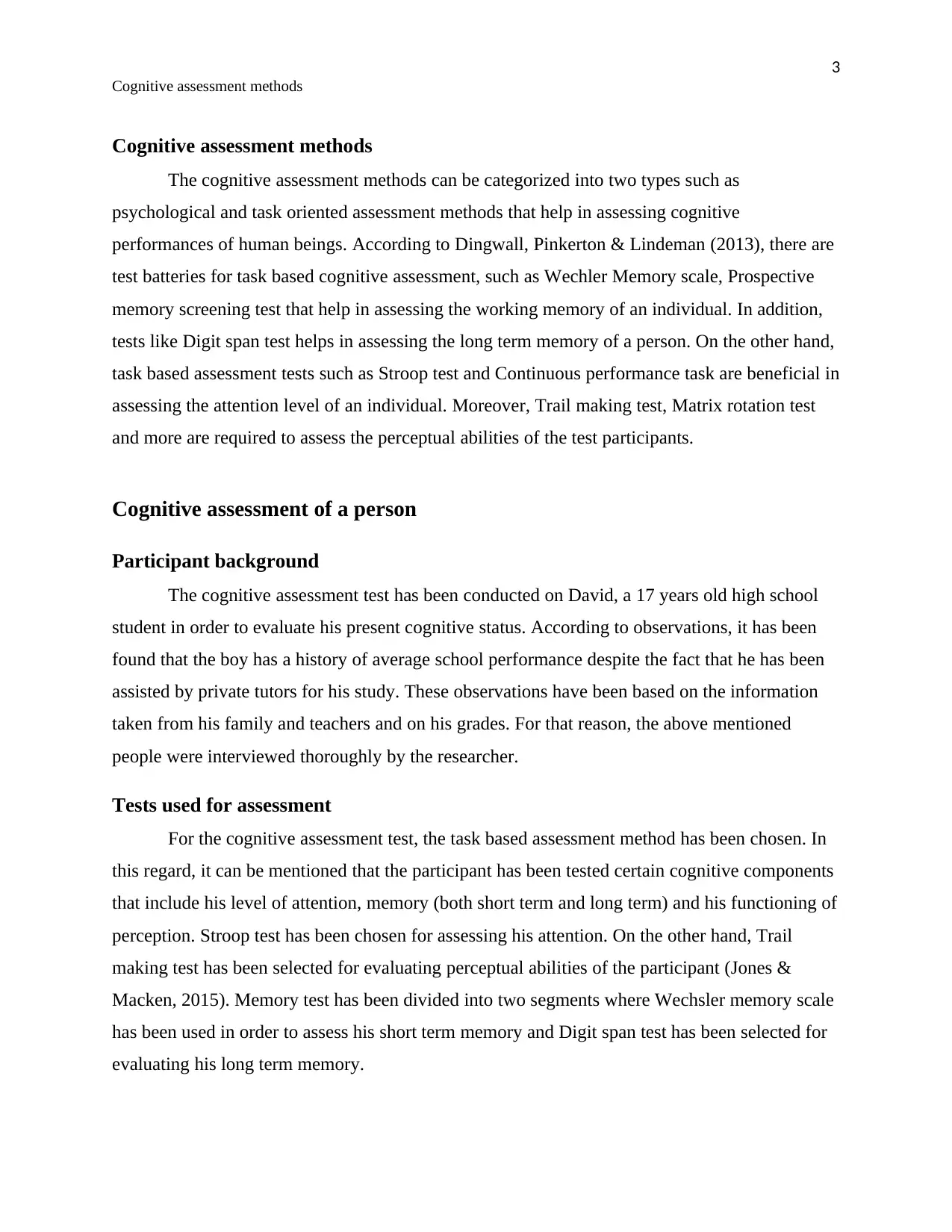
3
Cognitive assessment methods
Cognitive assessment methods
The cognitive assessment methods can be categorized into two types such as
psychological and task oriented assessment methods that help in assessing cognitive
performances of human beings. According to Dingwall, Pinkerton & Lindeman (2013), there are
test batteries for task based cognitive assessment, such as Wechler Memory scale, Prospective
memory screening test that help in assessing the working memory of an individual. In addition,
tests like Digit span test helps in assessing the long term memory of a person. On the other hand,
task based assessment tests such as Stroop test and Continuous performance task are beneficial in
assessing the attention level of an individual. Moreover, Trail making test, Matrix rotation test
and more are required to assess the perceptual abilities of the test participants.
Cognitive assessment of a person
Participant background
The cognitive assessment test has been conducted on David, a 17 years old high school
student in order to evaluate his present cognitive status. According to observations, it has been
found that the boy has a history of average school performance despite the fact that he has been
assisted by private tutors for his study. These observations have been based on the information
taken from his family and teachers and on his grades. For that reason, the above mentioned
people were interviewed thoroughly by the researcher.
Tests used for assessment
For the cognitive assessment test, the task based assessment method has been chosen. In
this regard, it can be mentioned that the participant has been tested certain cognitive components
that include his level of attention, memory (both short term and long term) and his functioning of
perception. Stroop test has been chosen for assessing his attention. On the other hand, Trail
making test has been selected for evaluating perceptual abilities of the participant (Jones &
Macken, 2015). Memory test has been divided into two segments where Wechsler memory scale
has been used in order to assess his short term memory and Digit span test has been selected for
evaluating his long term memory.
Cognitive assessment methods
Cognitive assessment methods
The cognitive assessment methods can be categorized into two types such as
psychological and task oriented assessment methods that help in assessing cognitive
performances of human beings. According to Dingwall, Pinkerton & Lindeman (2013), there are
test batteries for task based cognitive assessment, such as Wechler Memory scale, Prospective
memory screening test that help in assessing the working memory of an individual. In addition,
tests like Digit span test helps in assessing the long term memory of a person. On the other hand,
task based assessment tests such as Stroop test and Continuous performance task are beneficial in
assessing the attention level of an individual. Moreover, Trail making test, Matrix rotation test
and more are required to assess the perceptual abilities of the test participants.
Cognitive assessment of a person
Participant background
The cognitive assessment test has been conducted on David, a 17 years old high school
student in order to evaluate his present cognitive status. According to observations, it has been
found that the boy has a history of average school performance despite the fact that he has been
assisted by private tutors for his study. These observations have been based on the information
taken from his family and teachers and on his grades. For that reason, the above mentioned
people were interviewed thoroughly by the researcher.
Tests used for assessment
For the cognitive assessment test, the task based assessment method has been chosen. In
this regard, it can be mentioned that the participant has been tested certain cognitive components
that include his level of attention, memory (both short term and long term) and his functioning of
perception. Stroop test has been chosen for assessing his attention. On the other hand, Trail
making test has been selected for evaluating perceptual abilities of the participant (Jones &
Macken, 2015). Memory test has been divided into two segments where Wechsler memory scale
has been used in order to assess his short term memory and Digit span test has been selected for
evaluating his long term memory.
Paraphrase This Document
Need a fresh take? Get an instant paraphrase of this document with our AI Paraphraser
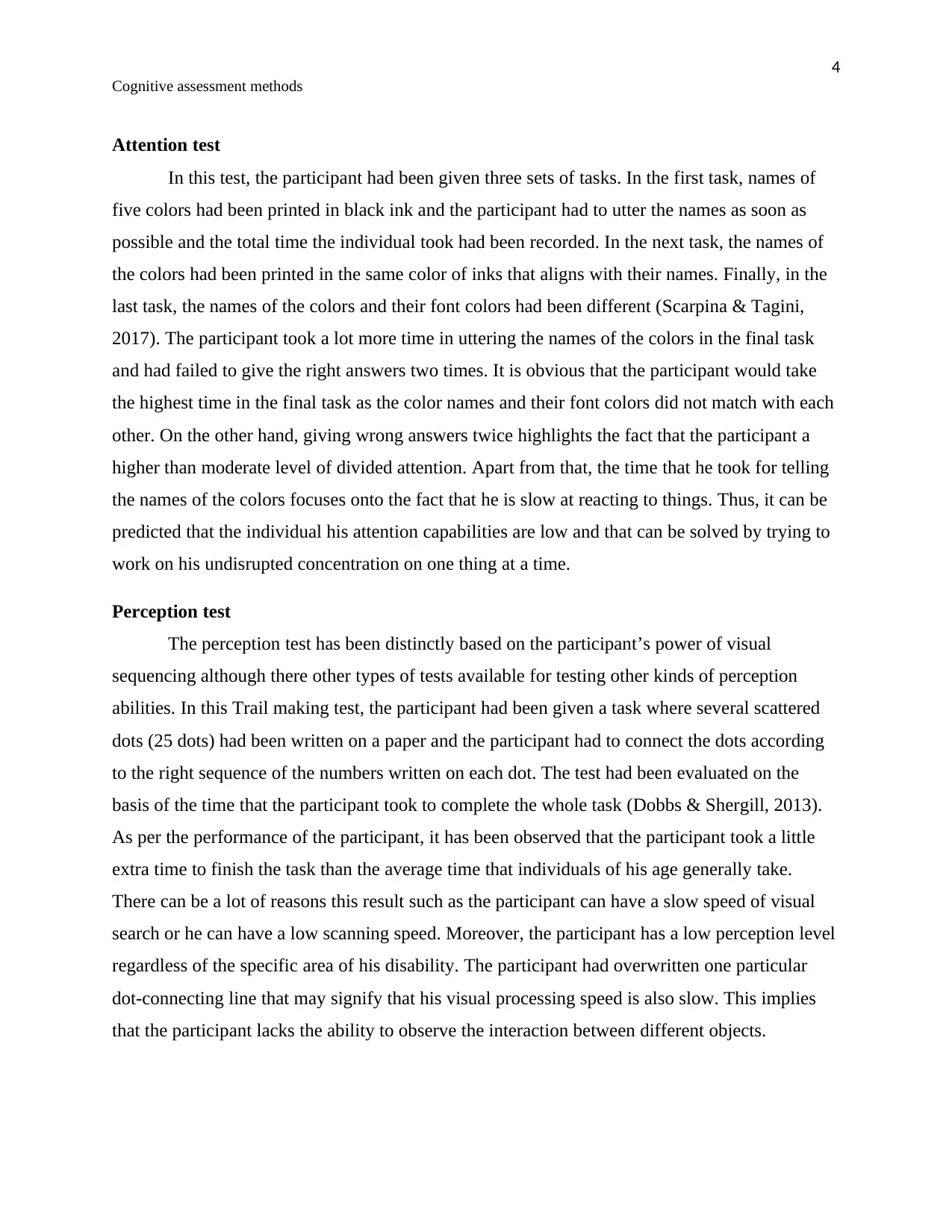
4
Cognitive assessment methods
Attention test
In this test, the participant had been given three sets of tasks. In the first task, names of
five colors had been printed in black ink and the participant had to utter the names as soon as
possible and the total time the individual took had been recorded. In the next task, the names of
the colors had been printed in the same color of inks that aligns with their names. Finally, in the
last task, the names of the colors and their font colors had been different (Scarpina & Tagini,
2017). The participant took a lot more time in uttering the names of the colors in the final task
and had failed to give the right answers two times. It is obvious that the participant would take
the highest time in the final task as the color names and their font colors did not match with each
other. On the other hand, giving wrong answers twice highlights the fact that the participant a
higher than moderate level of divided attention. Apart from that, the time that he took for telling
the names of the colors focuses onto the fact that he is slow at reacting to things. Thus, it can be
predicted that the individual his attention capabilities are low and that can be solved by trying to
work on his undisrupted concentration on one thing at a time.
Perception test
The perception test has been distinctly based on the participant’s power of visual
sequencing although there other types of tests available for testing other kinds of perception
abilities. In this Trail making test, the participant had been given a task where several scattered
dots (25 dots) had been written on a paper and the participant had to connect the dots according
to the right sequence of the numbers written on each dot. The test had been evaluated on the
basis of the time that the participant took to complete the whole task (Dobbs & Shergill, 2013).
As per the performance of the participant, it has been observed that the participant took a little
extra time to finish the task than the average time that individuals of his age generally take.
There can be a lot of reasons this result such as the participant can have a slow speed of visual
search or he can have a low scanning speed. Moreover, the participant has a low perception level
regardless of the specific area of his disability. The participant had overwritten one particular
dot-connecting line that may signify that his visual processing speed is also slow. This implies
that the participant lacks the ability to observe the interaction between different objects.
Cognitive assessment methods
Attention test
In this test, the participant had been given three sets of tasks. In the first task, names of
five colors had been printed in black ink and the participant had to utter the names as soon as
possible and the total time the individual took had been recorded. In the next task, the names of
the colors had been printed in the same color of inks that aligns with their names. Finally, in the
last task, the names of the colors and their font colors had been different (Scarpina & Tagini,
2017). The participant took a lot more time in uttering the names of the colors in the final task
and had failed to give the right answers two times. It is obvious that the participant would take
the highest time in the final task as the color names and their font colors did not match with each
other. On the other hand, giving wrong answers twice highlights the fact that the participant a
higher than moderate level of divided attention. Apart from that, the time that he took for telling
the names of the colors focuses onto the fact that he is slow at reacting to things. Thus, it can be
predicted that the individual his attention capabilities are low and that can be solved by trying to
work on his undisrupted concentration on one thing at a time.
Perception test
The perception test has been distinctly based on the participant’s power of visual
sequencing although there other types of tests available for testing other kinds of perception
abilities. In this Trail making test, the participant had been given a task where several scattered
dots (25 dots) had been written on a paper and the participant had to connect the dots according
to the right sequence of the numbers written on each dot. The test had been evaluated on the
basis of the time that the participant took to complete the whole task (Dobbs & Shergill, 2013).
As per the performance of the participant, it has been observed that the participant took a little
extra time to finish the task than the average time that individuals of his age generally take.
There can be a lot of reasons this result such as the participant can have a slow speed of visual
search or he can have a low scanning speed. Moreover, the participant has a low perception level
regardless of the specific area of his disability. The participant had overwritten one particular
dot-connecting line that may signify that his visual processing speed is also slow. This implies
that the participant lacks the ability to observe the interaction between different objects.
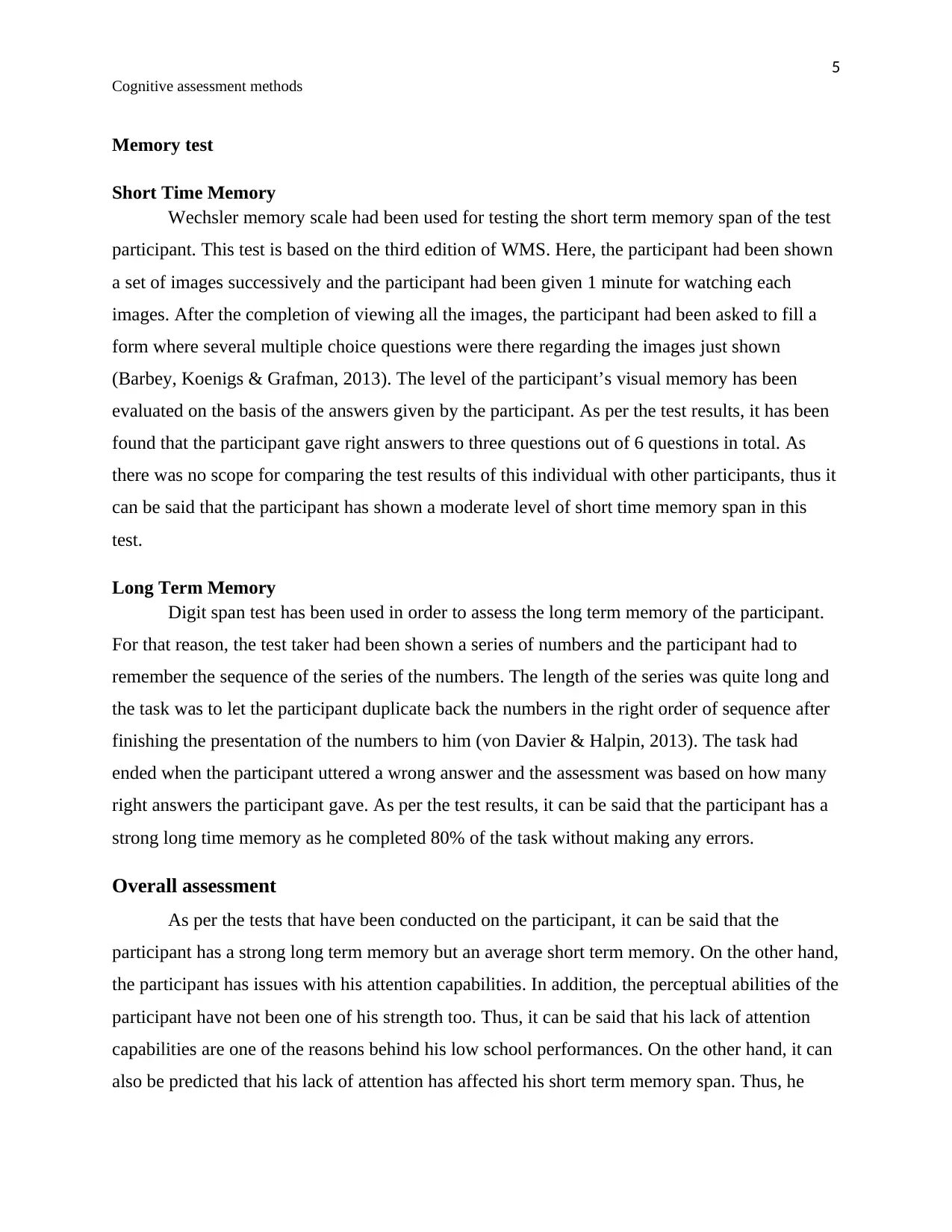
5
Cognitive assessment methods
Memory test
Short Time Memory
Wechsler memory scale had been used for testing the short term memory span of the test
participant. This test is based on the third edition of WMS. Here, the participant had been shown
a set of images successively and the participant had been given 1 minute for watching each
images. After the completion of viewing all the images, the participant had been asked to fill a
form where several multiple choice questions were there regarding the images just shown
(Barbey, Koenigs & Grafman, 2013). The level of the participant’s visual memory has been
evaluated on the basis of the answers given by the participant. As per the test results, it has been
found that the participant gave right answers to three questions out of 6 questions in total. As
there was no scope for comparing the test results of this individual with other participants, thus it
can be said that the participant has shown a moderate level of short time memory span in this
test.
Long Term Memory
Digit span test has been used in order to assess the long term memory of the participant.
For that reason, the test taker had been shown a series of numbers and the participant had to
remember the sequence of the series of the numbers. The length of the series was quite long and
the task was to let the participant duplicate back the numbers in the right order of sequence after
finishing the presentation of the numbers to him (von Davier & Halpin, 2013). The task had
ended when the participant uttered a wrong answer and the assessment was based on how many
right answers the participant gave. As per the test results, it can be said that the participant has a
strong long time memory as he completed 80% of the task without making any errors.
Overall assessment
As per the tests that have been conducted on the participant, it can be said that the
participant has a strong long term memory but an average short term memory. On the other hand,
the participant has issues with his attention capabilities. In addition, the perceptual abilities of the
participant have not been one of his strength too. Thus, it can be said that his lack of attention
capabilities are one of the reasons behind his low school performances. On the other hand, it can
also be predicted that his lack of attention has affected his short term memory span. Thus, he
Cognitive assessment methods
Memory test
Short Time Memory
Wechsler memory scale had been used for testing the short term memory span of the test
participant. This test is based on the third edition of WMS. Here, the participant had been shown
a set of images successively and the participant had been given 1 minute for watching each
images. After the completion of viewing all the images, the participant had been asked to fill a
form where several multiple choice questions were there regarding the images just shown
(Barbey, Koenigs & Grafman, 2013). The level of the participant’s visual memory has been
evaluated on the basis of the answers given by the participant. As per the test results, it has been
found that the participant gave right answers to three questions out of 6 questions in total. As
there was no scope for comparing the test results of this individual with other participants, thus it
can be said that the participant has shown a moderate level of short time memory span in this
test.
Long Term Memory
Digit span test has been used in order to assess the long term memory of the participant.
For that reason, the test taker had been shown a series of numbers and the participant had to
remember the sequence of the series of the numbers. The length of the series was quite long and
the task was to let the participant duplicate back the numbers in the right order of sequence after
finishing the presentation of the numbers to him (von Davier & Halpin, 2013). The task had
ended when the participant uttered a wrong answer and the assessment was based on how many
right answers the participant gave. As per the test results, it can be said that the participant has a
strong long time memory as he completed 80% of the task without making any errors.
Overall assessment
As per the tests that have been conducted on the participant, it can be said that the
participant has a strong long term memory but an average short term memory. On the other hand,
the participant has issues with his attention capabilities. In addition, the perceptual abilities of the
participant have not been one of his strength too. Thus, it can be said that his lack of attention
capabilities are one of the reasons behind his low school performances. On the other hand, it can
also be predicted that his lack of attention has affected his short term memory span. Thus, he
⊘ This is a preview!⊘
Do you want full access?
Subscribe today to unlock all pages.

Trusted by 1+ million students worldwide
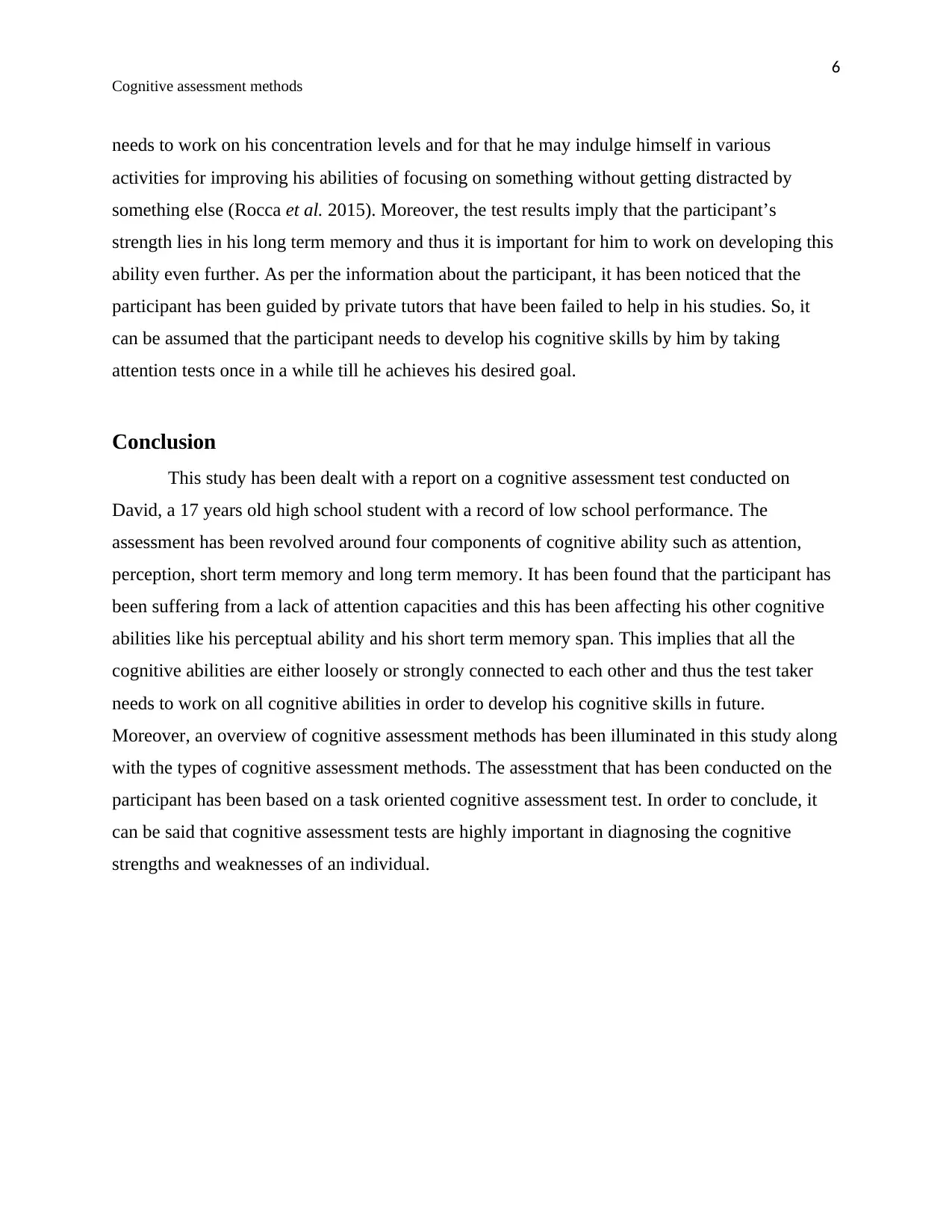
6
Cognitive assessment methods
needs to work on his concentration levels and for that he may indulge himself in various
activities for improving his abilities of focusing on something without getting distracted by
something else (Rocca et al. 2015). Moreover, the test results imply that the participant’s
strength lies in his long term memory and thus it is important for him to work on developing this
ability even further. As per the information about the participant, it has been noticed that the
participant has been guided by private tutors that have been failed to help in his studies. So, it
can be assumed that the participant needs to develop his cognitive skills by him by taking
attention tests once in a while till he achieves his desired goal.
Conclusion
This study has been dealt with a report on a cognitive assessment test conducted on
David, a 17 years old high school student with a record of low school performance. The
assessment has been revolved around four components of cognitive ability such as attention,
perception, short term memory and long term memory. It has been found that the participant has
been suffering from a lack of attention capacities and this has been affecting his other cognitive
abilities like his perceptual ability and his short term memory span. This implies that all the
cognitive abilities are either loosely or strongly connected to each other and thus the test taker
needs to work on all cognitive abilities in order to develop his cognitive skills in future.
Moreover, an overview of cognitive assessment methods has been illuminated in this study along
with the types of cognitive assessment methods. The assesstment that has been conducted on the
participant has been based on a task oriented cognitive assessment test. In order to conclude, it
can be said that cognitive assessment tests are highly important in diagnosing the cognitive
strengths and weaknesses of an individual.
Cognitive assessment methods
needs to work on his concentration levels and for that he may indulge himself in various
activities for improving his abilities of focusing on something without getting distracted by
something else (Rocca et al. 2015). Moreover, the test results imply that the participant’s
strength lies in his long term memory and thus it is important for him to work on developing this
ability even further. As per the information about the participant, it has been noticed that the
participant has been guided by private tutors that have been failed to help in his studies. So, it
can be assumed that the participant needs to develop his cognitive skills by him by taking
attention tests once in a while till he achieves his desired goal.
Conclusion
This study has been dealt with a report on a cognitive assessment test conducted on
David, a 17 years old high school student with a record of low school performance. The
assessment has been revolved around four components of cognitive ability such as attention,
perception, short term memory and long term memory. It has been found that the participant has
been suffering from a lack of attention capacities and this has been affecting his other cognitive
abilities like his perceptual ability and his short term memory span. This implies that all the
cognitive abilities are either loosely or strongly connected to each other and thus the test taker
needs to work on all cognitive abilities in order to develop his cognitive skills in future.
Moreover, an overview of cognitive assessment methods has been illuminated in this study along
with the types of cognitive assessment methods. The assesstment that has been conducted on the
participant has been based on a task oriented cognitive assessment test. In order to conclude, it
can be said that cognitive assessment tests are highly important in diagnosing the cognitive
strengths and weaknesses of an individual.
Paraphrase This Document
Need a fresh take? Get an instant paraphrase of this document with our AI Paraphraser
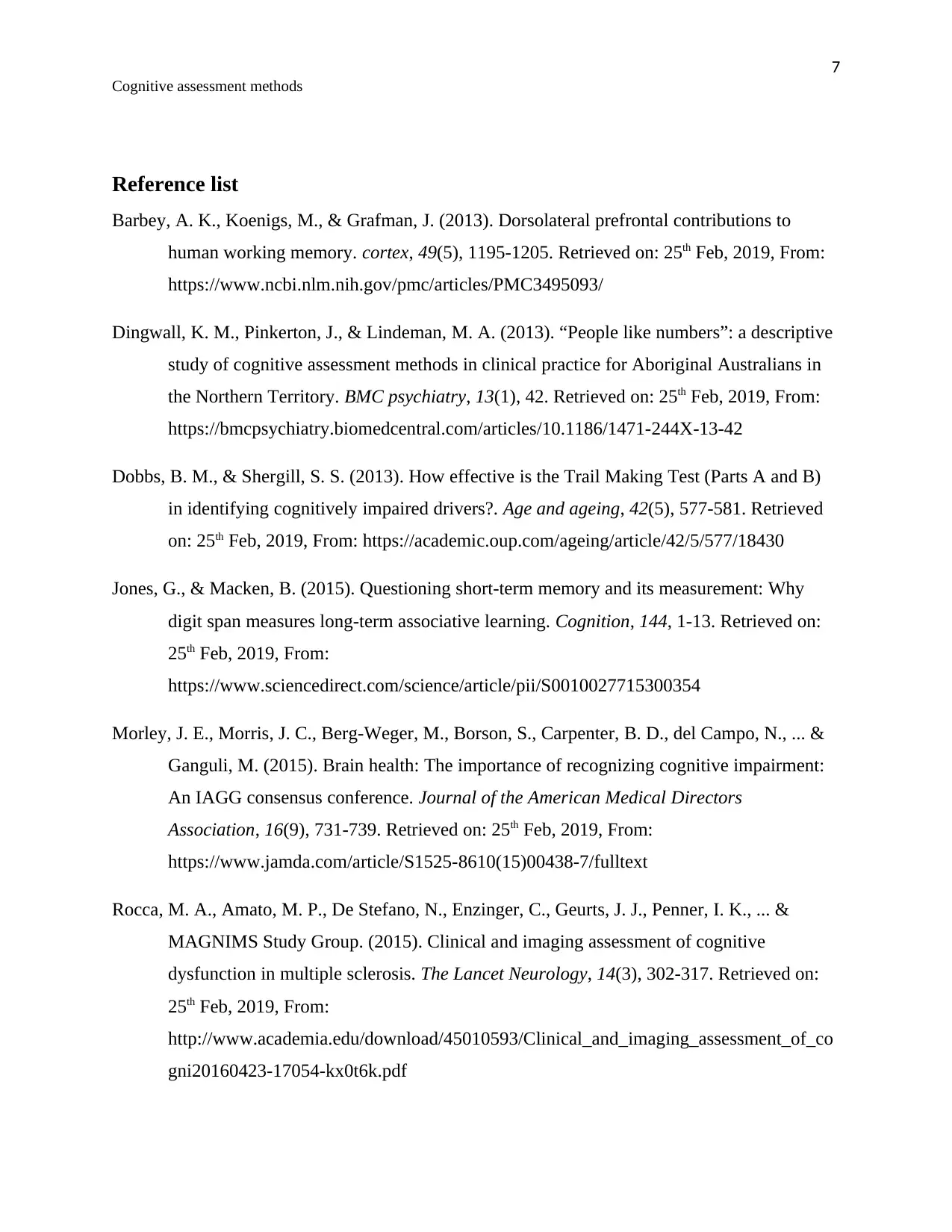
7
Cognitive assessment methods
Reference list
Barbey, A. K., Koenigs, M., & Grafman, J. (2013). Dorsolateral prefrontal contributions to
human working memory. cortex, 49(5), 1195-1205. Retrieved on: 25th Feb, 2019, From:
https://www.ncbi.nlm.nih.gov/pmc/articles/PMC3495093/
Dingwall, K. M., Pinkerton, J., & Lindeman, M. A. (2013). “People like numbers”: a descriptive
study of cognitive assessment methods in clinical practice for Aboriginal Australians in
the Northern Territory. BMC psychiatry, 13(1), 42. Retrieved on: 25th Feb, 2019, From:
https://bmcpsychiatry.biomedcentral.com/articles/10.1186/1471-244X-13-42
Dobbs, B. M., & Shergill, S. S. (2013). How effective is the Trail Making Test (Parts A and B)
in identifying cognitively impaired drivers?. Age and ageing, 42(5), 577-581. Retrieved
on: 25th Feb, 2019, From: https://academic.oup.com/ageing/article/42/5/577/18430
Jones, G., & Macken, B. (2015). Questioning short-term memory and its measurement: Why
digit span measures long-term associative learning. Cognition, 144, 1-13. Retrieved on:
25th Feb, 2019, From:
https://www.sciencedirect.com/science/article/pii/S0010027715300354
Morley, J. E., Morris, J. C., Berg-Weger, M., Borson, S., Carpenter, B. D., del Campo, N., ... &
Ganguli, M. (2015). Brain health: The importance of recognizing cognitive impairment:
An IAGG consensus conference. Journal of the American Medical Directors
Association, 16(9), 731-739. Retrieved on: 25th Feb, 2019, From:
https://www.jamda.com/article/S1525-8610(15)00438-7/fulltext
Rocca, M. A., Amato, M. P., De Stefano, N., Enzinger, C., Geurts, J. J., Penner, I. K., ... &
MAGNIMS Study Group. (2015). Clinical and imaging assessment of cognitive
dysfunction in multiple sclerosis. The Lancet Neurology, 14(3), 302-317. Retrieved on:
25th Feb, 2019, From:
http://www.academia.edu/download/45010593/Clinical_and_imaging_assessment_of_co
gni20160423-17054-kx0t6k.pdf
Cognitive assessment methods
Reference list
Barbey, A. K., Koenigs, M., & Grafman, J. (2013). Dorsolateral prefrontal contributions to
human working memory. cortex, 49(5), 1195-1205. Retrieved on: 25th Feb, 2019, From:
https://www.ncbi.nlm.nih.gov/pmc/articles/PMC3495093/
Dingwall, K. M., Pinkerton, J., & Lindeman, M. A. (2013). “People like numbers”: a descriptive
study of cognitive assessment methods in clinical practice for Aboriginal Australians in
the Northern Territory. BMC psychiatry, 13(1), 42. Retrieved on: 25th Feb, 2019, From:
https://bmcpsychiatry.biomedcentral.com/articles/10.1186/1471-244X-13-42
Dobbs, B. M., & Shergill, S. S. (2013). How effective is the Trail Making Test (Parts A and B)
in identifying cognitively impaired drivers?. Age and ageing, 42(5), 577-581. Retrieved
on: 25th Feb, 2019, From: https://academic.oup.com/ageing/article/42/5/577/18430
Jones, G., & Macken, B. (2015). Questioning short-term memory and its measurement: Why
digit span measures long-term associative learning. Cognition, 144, 1-13. Retrieved on:
25th Feb, 2019, From:
https://www.sciencedirect.com/science/article/pii/S0010027715300354
Morley, J. E., Morris, J. C., Berg-Weger, M., Borson, S., Carpenter, B. D., del Campo, N., ... &
Ganguli, M. (2015). Brain health: The importance of recognizing cognitive impairment:
An IAGG consensus conference. Journal of the American Medical Directors
Association, 16(9), 731-739. Retrieved on: 25th Feb, 2019, From:
https://www.jamda.com/article/S1525-8610(15)00438-7/fulltext
Rocca, M. A., Amato, M. P., De Stefano, N., Enzinger, C., Geurts, J. J., Penner, I. K., ... &
MAGNIMS Study Group. (2015). Clinical and imaging assessment of cognitive
dysfunction in multiple sclerosis. The Lancet Neurology, 14(3), 302-317. Retrieved on:
25th Feb, 2019, From:
http://www.academia.edu/download/45010593/Clinical_and_imaging_assessment_of_co
gni20160423-17054-kx0t6k.pdf
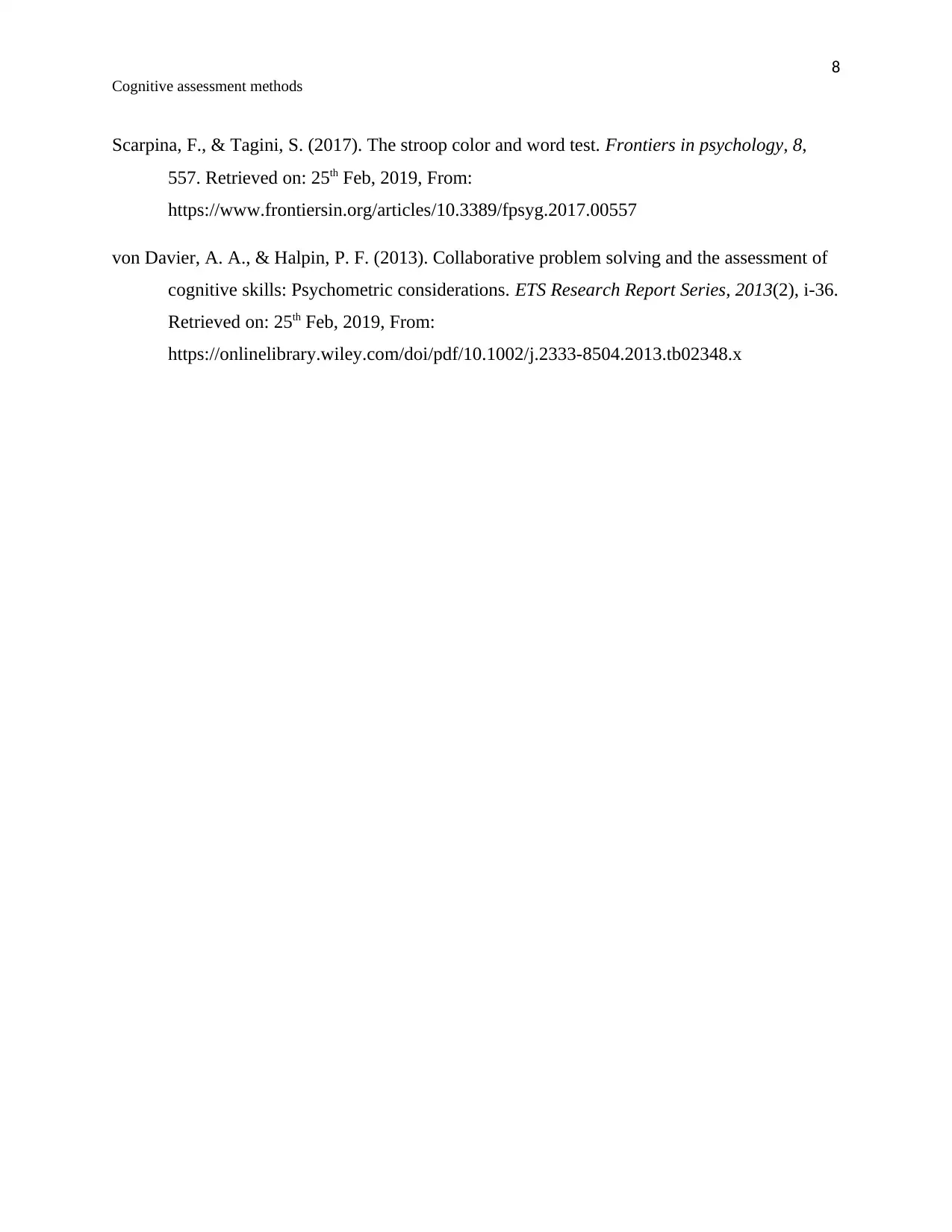
8
Cognitive assessment methods
Scarpina, F., & Tagini, S. (2017). The stroop color and word test. Frontiers in psychology, 8,
557. Retrieved on: 25th Feb, 2019, From:
https://www.frontiersin.org/articles/10.3389/fpsyg.2017.00557
von Davier, A. A., & Halpin, P. F. (2013). Collaborative problem solving and the assessment of
cognitive skills: Psychometric considerations. ETS Research Report Series, 2013(2), i-36.
Retrieved on: 25th Feb, 2019, From:
https://onlinelibrary.wiley.com/doi/pdf/10.1002/j.2333-8504.2013.tb02348.x
Cognitive assessment methods
Scarpina, F., & Tagini, S. (2017). The stroop color and word test. Frontiers in psychology, 8,
557. Retrieved on: 25th Feb, 2019, From:
https://www.frontiersin.org/articles/10.3389/fpsyg.2017.00557
von Davier, A. A., & Halpin, P. F. (2013). Collaborative problem solving and the assessment of
cognitive skills: Psychometric considerations. ETS Research Report Series, 2013(2), i-36.
Retrieved on: 25th Feb, 2019, From:
https://onlinelibrary.wiley.com/doi/pdf/10.1002/j.2333-8504.2013.tb02348.x
⊘ This is a preview!⊘
Do you want full access?
Subscribe today to unlock all pages.

Trusted by 1+ million students worldwide
1 out of 9
Related Documents
Your All-in-One AI-Powered Toolkit for Academic Success.
+13062052269
info@desklib.com
Available 24*7 on WhatsApp / Email
![[object Object]](/_next/static/media/star-bottom.7253800d.svg)
Unlock your academic potential
Copyright © 2020–2025 A2Z Services. All Rights Reserved. Developed and managed by ZUCOL.




